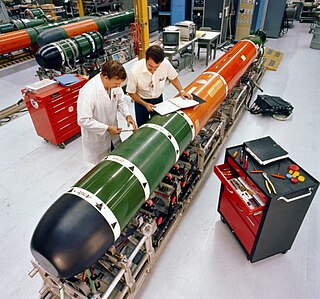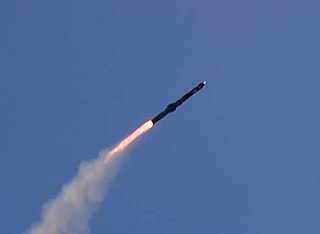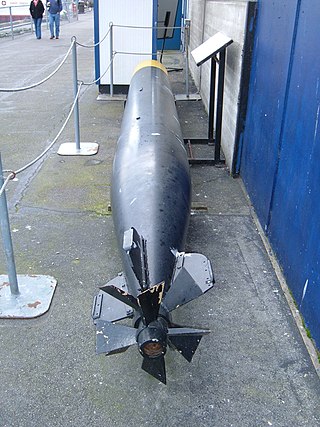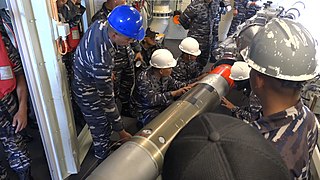Related Research Articles

A modern torpedo is an underwater ranged weapon launched above or below the water surface, self-propelled towards a target, and with an explosive warhead designed to detonate either on contact with or in proximity to the target. Historically, such a device was called an automotive, automobile, locomotive, or fish torpedo; colloquially a fish. The term torpedo originally applied to a variety of devices, most of which would today be called mines. From about 1900, torpedo has been used strictly to designate a self-propelled underwater explosive device.

Kaiten were crewed torpedoes and suicide craft, used by the Imperial Japanese Navy in the final stages of World War II.

The Mark 48 and its improved Advanced Capability (ADCAP) variant are American heavyweight submarine-launched torpedoes. They were designed to sink deep-diving nuclear-powered submarines and high-performance surface ships.

The Mark 46 torpedo is the backbone of the United States Navy's lightweight anti-submarine warfare torpedo inventory and is the NATO standard. These aerial torpedoes are designed to attack high-performance submarines. In 1989, an improvement program for the Mod 5 to the Mod 5A and Mod 5A(S) increased its shallow-water performance. The Mark 46 was initially developed as Research Torpedo Concept I, one of several weapons recommended for implementation by Project Nobska, a 1956 summer study on submarine warfare.

The RUM-139 Vertical-Launch Anti-Submarine Rocket is an anti-submarine missile in the ASROC family, currently built by Lockheed Martin for the U.S. Navy.

The Mark 44 torpedo is a now-obsolete air-launched and ship-launched lightweight torpedo manufactured in the United States, and under licence in Canada, France, Italy, Japan and the United Kingdom, with 10,500 being produced for U.S. service. It was superseded by the Mark 46 torpedo, beginning in the late 1960s. The Royal Australian Navy, however, continued to use it alongside its successor for a number of years, because the Mark 44 was thought to have superior performance in certain shallow-water conditions.

The Mark 13 torpedo was the U.S. Navy's most common aerial torpedo of World War II. It was the first American torpedo to be originally designed for launching from aircraft only. They were also used on PT boats.

The Mark 24 mine is an air-dropped anti-submarine (ASW) acoustic torpedo developed by the United States during World War II; it was called a mine to conceal its capabilities. The torpedo entered service with the Allies in March 1943; the United States Navy (USN) used it until 1948. Approximately 4,000 were produced. Of the 340 deployed during the war, 204 were fired, sinking 37 and damaging 18 Axis submarines.

The Howell Automobile Torpedo was the first self-propelled torpedo produced in quantity by the United States Navy, which referred to it as the Howell Mark I torpedo. It was conceived by Lieutenant Commander John A. Howell, United States Navy, in 1870, using a 60 kg (130 lb) flywheel spun at a very high speed to store energy and drive propellers.

The Mark 37 torpedo is a torpedo with electrical propulsion, developed for the US Navy after World War II. It entered service with the US Navy in the early 1950s, with over 3,300 produced. It was phased out of service with the US Navy during the 1970s, and the stockpiles were sold to foreign navies.

The Mark 14 torpedo was the United States Navy's standard submarine-launched anti-ship torpedo of World War II. This weapon was plagued with many problems which crippled its performance early in the war. It was supplemented by the Mark 18 electric torpedo in the last two years of the war. From December 1941 to November 1943 the Mark 14 and the destroyer-launched Mark 15 torpedo had numerous technical problems that took almost two years to fix. After the fixes, the Mark 14 played a major role in the devastating blow U.S. Navy submarines dealt to the Japanese naval and merchant marine forces during the Pacific War.

The Mark 15 torpedo was the standard American destroyer-launched torpedo of World War II. It was very similar in design to the Mark 14 torpedo except that it was longer, heavier, and had greater range and a larger warhead. The Mark 15 was developed by the Naval Torpedo Station Newport concurrently with the Mark 14 and was first deployed in 1938. It served as a replacement for the Mark 8 torpedo, Mark 11 Torpedo and Mark 12 Torpedo on surface ships with tubes that could accommodate the longer Mark 15; this primarily included destroyers built after 1930. Older destroyers, primarily the Wickes and Clemson classes, continued to use the Mark 8, as did PT boats early in World War II. During the war 9,700 were produced at Newport and at the Naval Ordnance Station Forest Park, Illinois.

The A244/S is an Italian lightweight, fire-and-forget torpedo employed for anti-submarine warfare. It can be launched from surface vessels or aircraft and locates the target using an acoustic seeker. The torpedo body conforms to the NATO 12.75-inch standard and is compatible with USN Mark 32 torpedo tubes.
Yu-5 (鱼-5) torpedo is the first wire-guided torpedo developed by China. It is an ASW torpedo designed for conventional diesel-electric submarines. It is often erroneously referred as the Chinese copy of Soviet TEST-71 torpedo, which is incorrect as the Soviet torpedo was developed in 1971 and its successor TEST-71MKE was developed in 1977, at the worst time of Sino-Soviet split. With Yu-5 entering Chinese service in 1989, it was simply impossible to acquire any technologies of Soviet TEST-71 torpedo, which was not purchased by China until 1993, four years after the Yu-5 torpedo had already entered service. The Yu-5 is not a product of indigenous development and is based largely upon previous Soviet and American designs, with much of the propulsion system being derived from the American Mark 46 lightweight torpedo.
The Mark 35 torpedo was the first of the United States Navy deep-diving anti-submarine torpedoes designed for surface launch. This electrically propelled 21-inch (53-cm) torpedo was 162 inches long, weighed 1770 lb (803 kg), and carried a 270 lb (122.5 kg) Torpex high explosive warhead. This torpedo used one of the earliest active guidance systems and was introduced in 1949, and was classified as obsolete in the 1960s.
There have been a number of 21-inch (53.3cm) torpedoes in service with the Royal Navy of the United Kingdom.
The Whitehead Mark 5 torpedo was a Whitehead torpedo adopted by the United States Navy for use in an anti-surface ship role in 1910. The Mark 5 was the first torpedo to be manufactured by a foreign company, the Whitehead facility in the United Kingdom, and in 1908, by the Naval Torpedo Station in Newport, Rhode Island. It was also the first torpedo to allow the firing ship to vary the torpedo's speed and range.
The Mark 19 torpedo was an electric torpedo designed in 1942 by Westinghouse Electric as a follow-on development of the Mark 18 torpedo. The goal was to build a torpedo that incorporated all-electric controls in place of pneumatic controls. Its gyroscope and depth control were electrically controlled and operated, while the rudders were solenoid operated.
The Mark 31 torpedo was a destroyer-launched acoustic torpedo developed by the Harvard and Pennsylvania State universities during World War II. A modification of the Mark 18 electric torpedo, it was conceived as an interim weapon to be used in the Pacific War until a new high-speed acoustic torpedo could be developed for the United States Navy.

Torpedo trials craft are primarily naval auxiliaries used by navies for the development of new naval torpedoes and during practise firings. These craft are designed to track and monitor the torpedo and to be able to locate and retrieve the spent torpedo for analysis, and refurbishment for reuse. Torpedo trials craft had their greatest use during the years around World War II when the torpedo was the primary anti-ship weapon of submarines, destroyers and naval aircraft.